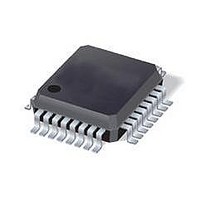C8051F350 Silicon Laboratories Inc, C8051F350 Datasheet - Page 127

C8051F350
Manufacturer Part Number
C8051F350
Description
IC 8051 MCU 8K FLASH 32LQFP
Manufacturer
Silicon Laboratories Inc
Series
C8051F35xr
Specifications of C8051F350
Core Processor
8051
Core Size
8-Bit
Speed
50MHz
Connectivity
SMBus (2-Wire/I²C), SPI, UART/USART
Peripherals
POR, PWM, Temp Sensor, WDT
Number Of I /o
17
Program Memory Size
8KB (8K x 8)
Program Memory Type
FLASH
Ram Size
768 x 8
Voltage - Supply (vcc/vdd)
2.7 V ~ 3.6 V
Data Converters
A/D 8x24b; D/A 2x8b
Oscillator Type
Internal
Operating Temperature
-40°C ~ 85°C
Package / Case
32-LQFP
Data Bus Width
8 bit
Data Rom Size
128 B
On-chip Adc
10 bit
Number Of Timers
16 bit
Operating Supply Voltage
2.7 V to 3.6 V
Mounting Style
SMD/SMT
Height
1.4 mm
Length
7 mm
Maximum Operating Temperature
+ 85 C
Minimum Operating Temperature
- 40 C
Width
7 mm
Lead Free Status / RoHS Status
Contains lead / RoHS non-compliant
Eeprom Size
-
Lead Free Status / Rohs Status
No RoHS Version Available
Available stocks
Company
Part Number
Manufacturer
Quantity
Price
Company:
Part Number:
C8051F350
Manufacturer:
Silicon Laboratories Inc
Quantity:
10 000
Part Number:
C8051F350
Manufacturer:
SILICON LABS/芯科
Quantity:
20 000
Company:
Part Number:
C8051F350-GQ
Manufacturer:
SiliconL
Quantity:
3 029
Company:
Part Number:
C8051F350-GQ
Manufacturer:
SILICON
Quantity:
18
Company:
Part Number:
C8051F350-GQ
Manufacturer:
Silicon Laboratories Inc
Quantity:
10 000
Company:
Part Number:
C8051F350-GQR
Manufacturer:
Silicon Laboratories Inc
Quantity:
10 000
Part Number:
C8051F350-GQR
Manufacturer:
SILICON LABS/芯科
Quantity:
20 000
Company:
Part Number:
C8051F350DK
Manufacturer:
SiliconL
Quantity:
8
Company:
Part Number:
C8051F350R
Manufacturer:
Silicon Laboratories Inc
Quantity:
10 000
17.2. External Oscillator Drive Circuit
The external oscillator circuit may drive an external crystal, ceramic resonator, capacitor, or RC network. A
CMOS clock may also provide a clock input. For a crystal or ceramic resonator configuration, the crys-
tal/resonator must be wired across the XTAL1 and XTAL2 pins as shown in Option 1 of Figure 17.1. A
10 MΩ resistor also must be wired across the XTAL1 and XTAL2 pins for the crystal/resonator configura-
tion. In RC, capacitor, or CMOS clock configuration, the clock source should be wired to the XTAL2 pin as
shown in Option 2, 3, or 4 of Figure 17.1. The type of external oscillator must be selected in the OSCXCN
register, and the frequency control bits (XFCN) must be selected appropriately (see Figure 17.4)
Important Note on External Oscillator Usage: Port pins must be configured when using the external
oscillator circuit. When the external oscillator drive circuit is enabled in crystal/resonator mode, Port pins
P0.2 and P0.3 are used as XTAL1 and XTAL2 respectively. When the external oscillator drive circuit is
enabled in capacitor, RC, or CMOS clock mode, Port pin P0.3 is used as XTAL2. The Port I/O Crossbar
should be configured to skip the Port pins used by the oscillator circuit; see
Decoder” on page 135
crystal/resonator, capacitor, or RC mode, the associated Port pins should be configured as analog inputs.
In CMOS clock mode, the associated pin should be configured as a digital input. See
I/O Initialization” on page 137
17.2.1. Clocking Timers Directly Through the External Oscillator
The external oscillator source divided by eight is a clock option for the timers
page
page
clock, the external oscillator frequency must be less than or equal to the system clock frequency. In this
configuration, the clock supplied to the peripheral (external oscillator / 8) is synchronized with the system
clock; the jitter associated with this synchronization is limited to ±0.5 system clock cycles.
17.2.2. External Crystal Example
If a crystal or ceramic resonator is used as an external oscillator source for the MCU, the circuit should be
configured as shown in Figure 17.1, Option 1. The External Oscillator Frequency Control value (XFCN)
should be chosen from the Crystal column of the table in Figure 17.4 (OSCXCN register). For example, a
12 MHz crystal requires an XFCN setting of 111b.
When the crystal oscillator is first enabled, the oscillator amplitude detection circuit requires a settling time
to achieve proper bias. Introducing a delay of 1 ms between enabling the oscillator and checking the
XTLVLD bit will prevent a premature switch to the external oscillator as the system clock. Switching to the
external oscillator before the crystal oscillator has stabilized can result in unpredictable behavior. The rec-
ommended procedure is:
Important note on external crystals: Crystal oscillator circuits are quite sensitive to PCB layout. The
crystal should be placed as close as possible to the XTAL pins on the device. The traces should be as
short as possible and shielded with ground plane from any other traces which could introduce noise or
interference.
191) and the Programmable Counter Array (PCA)
207). When the external oscillator is used to clock these peripherals, but is not used as the system
Step 1. Enable the external oscillator.
Step 2. Wait at least 1 ms.
Step 3. Poll for XTLVLD => ‘1’.
Step 4. Switch the system clock to the external oscillator.
for Crossbar configuration. Additionally, when using the external oscillator circuit in
for details on Port input mode selection.
Rev. 0.4
(Section “23. Programmable Counter Array” on
C8051F350/1/2/3
Section “18.1. Priority Crossbar
(Section “22. Timers” on
Section “18.2. Port
127











